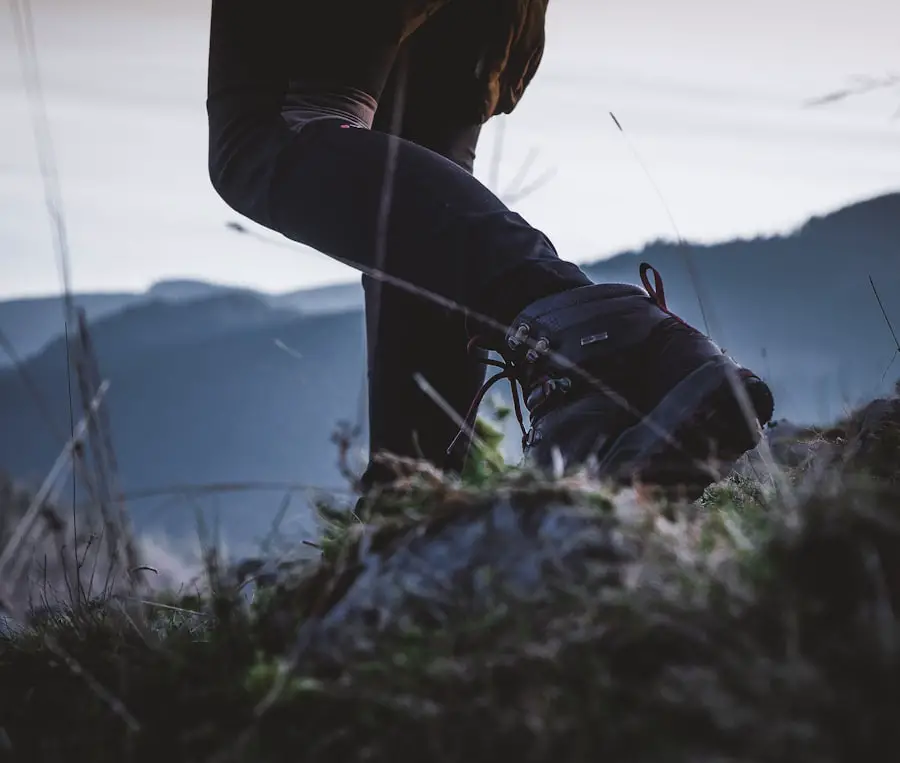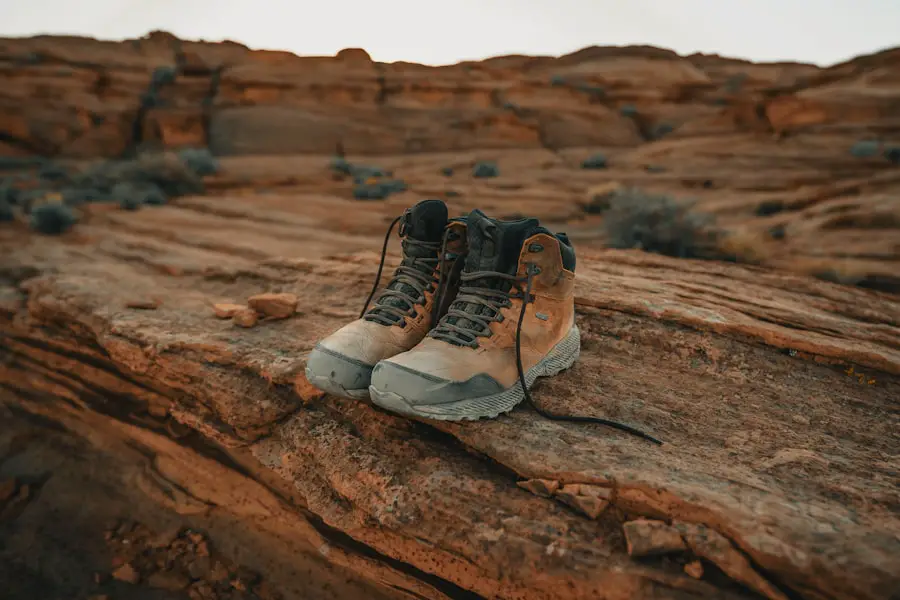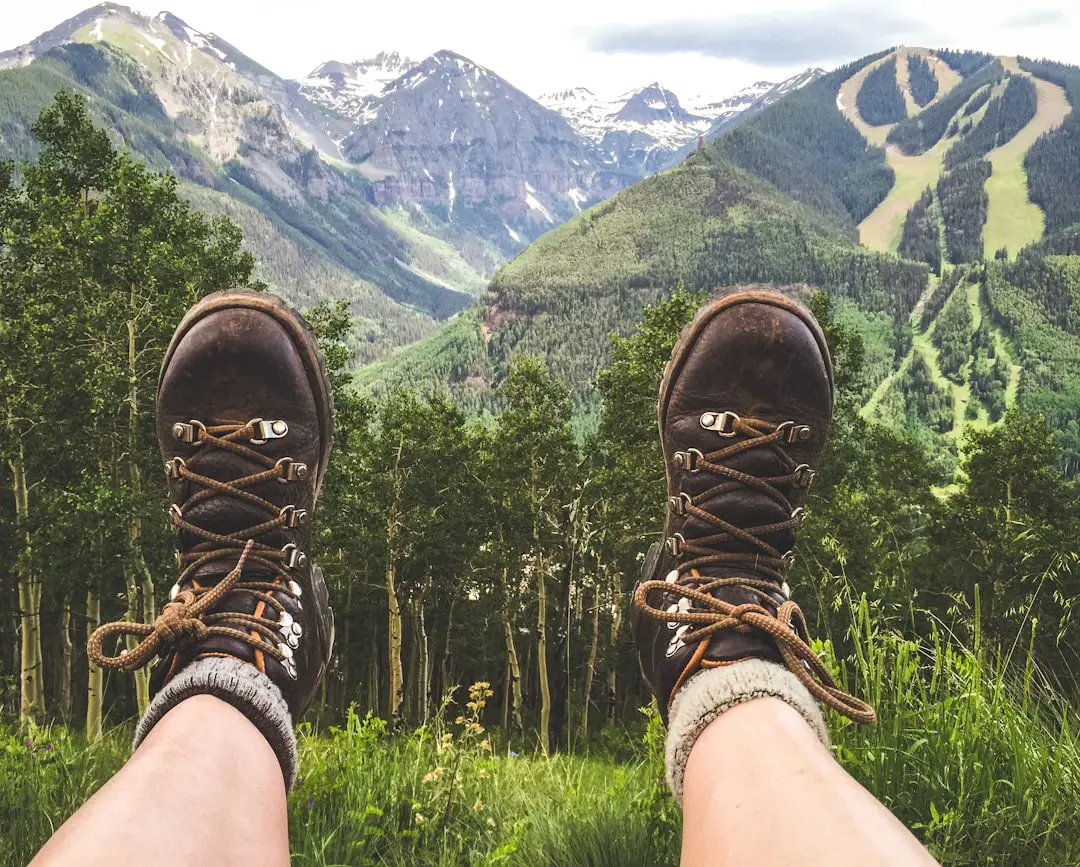Downhill hiking, often perceived as a less strenuous counterpart to ascending trails, presents its own unique set of challenges and rewards. Unlike the upward trek, which primarily engages the cardiovascular system and builds endurance, descending requires a different approach that emphasizes control, balance, and technique. The mechanics of downhill hiking involve not just the act of moving downward but also managing the forces acting on the body, such as gravity and momentum.
This understanding is crucial for hikers who wish to navigate steep terrains safely and efficiently. The terrain can vary significantly, from rocky paths to smooth dirt trails, each presenting distinct challenges. For instance, a rocky descent may require more careful foot placement and a lower center of gravity to maintain stability, while a smooth trail might allow for a quicker pace.
Understanding these nuances is essential for hikers to adapt their techniques accordingly. Additionally, the psychological aspect of downhill hiking cannot be overlooked; many hikers experience a sense of exhilaration when descending, but this can lead to overconfidence and potential injury if proper techniques are not employed.
Key Takeaways
- Downhill hiking requires understanding proper technique and body mechanics to prevent injury and improve performance.
- Selecting the right gear, including sturdy footwear and trekking poles, is essential for a safe and comfortable downhill hiking experience.
- Building lower body strength through exercises like squats and lunges can help improve stability and control during descents.
- Improving balance and coordination through activities like yoga and balance exercises can enhance safety and confidence on steep terrain.
- Practicing proper foot placement and technique, such as using short, quick steps and maintaining a slight forward lean, can help prevent fatigue and reduce strain on the body during downhill hiking.
Selecting the Right Gear for Downhill Hiking
Choosing the appropriate gear is paramount for a successful downhill hiking experience. Footwear is arguably the most critical component; a good pair of hiking shoes or boots should provide ample grip, support, and cushioning. Shoes with a rugged outsole can help prevent slips on loose gravel or wet surfaces, while those with adequate ankle support can protect against sprains during sudden shifts in weight.
It’s also advisable to consider the terrain when selecting footwear; for instance, trail runners may be suitable for well-maintained paths, while heavier boots might be necessary for rocky or uneven ground. In addition to footwear, other gear considerations include trekking poles, which can significantly enhance stability and reduce strain on the knees during descents. Poles allow hikers to distribute their weight more evenly and provide additional points of contact with the ground, which can be particularly beneficial on steep or slippery sections.
Furthermore, wearing appropriate clothing that wicks moisture and provides insulation can help maintain comfort levels throughout the hike. Layering is often recommended to adapt to changing weather conditions, ensuring that hikers remain dry and warm without overheating.
Building Lower Body Strength for Descending

Developing lower body strength is essential for mastering downhill hiking techniques. The muscles in the legs—particularly the quadriceps, hamstrings, calves, and glutes—play a pivotal role in controlling descent and absorbing impact. Strengthening these muscle groups can enhance stability and reduce fatigue during long hikes.
Exercises such as squats, lunges, and step-ups are effective for building strength in these areas. Incorporating resistance training into a regular fitness routine can also yield significant benefits; using weights or resistance bands can increase muscle engagement and promote greater strength gains. In addition to traditional strength training exercises, functional movements that mimic the actions of hiking can be particularly beneficial.
For example, practicing downhill walking on a treadmill set to an incline can help simulate the experience of descending trails while allowing for controlled practice in a safe environment. Plyometric exercises like box jumps or jump squats can also improve explosive strength and power in the legs, which is useful for navigating uneven terrain quickly and efficiently.
Improving Balance and Coordination for Steep Terrain
| Technique | Frequency | Duration |
|---|---|---|
| Single-leg balance exercises | 3 times a week | 15 minutes |
| Coordination drills | 2 times a week | 20 minutes |
| Strength training for lower body | 3 times a week | 30 minutes |
Balance and coordination are critical skills for any hiker, especially when traversing steep or uneven terrain. The ability to maintain stability while navigating obstacles such as rocks, roots, or sudden drops can mean the difference between a safe descent and a potential fall. Engaging in activities that promote balance—such as yoga or tai chi—can enhance proprioception, which is the body’s awareness of its position in space.
These practices encourage mindfulness and body control, both of which are essential when maneuvering down challenging trails. Incorporating balance exercises into a training regimen can also be beneficial. Simple activities like standing on one leg or using balance boards can improve core stability and leg strength.
More advanced exercises might include dynamic movements such as lateral hops or agility drills that require quick changes in direction. These activities not only enhance physical balance but also train the mind to react swiftly to unexpected changes in terrain during hikes.
Practicing Proper Foot Placement and Technique
Proper foot placement is fundamental to safe and effective downhill hiking. Each step should be deliberate; placing the foot correctly can help prevent slips and falls while ensuring that the body remains balanced. Hikers should aim to land their feet flat rather than on their toes or heels to distribute weight evenly across the foot.
This technique helps absorb shock and reduces strain on the knees and ankles. Additionally, keeping the knees slightly bent during descent allows for better shock absorption and control. Technique also plays a significant role in maintaining momentum while descending.
Hikers should lean slightly forward from their hips rather than their waist, which helps keep the center of gravity over the feet. This posture not only aids in balance but also allows for quicker adjustments if the terrain becomes unstable. Practicing these techniques on varied surfaces can help hikers become more adept at adjusting their foot placement based on changing conditions.
Developing Endurance for Long Descents

Endurance is a crucial component of downhill hiking, particularly on longer trails where fatigue can set in quickly. Building cardiovascular endurance through activities such as running, cycling, or swimming can enhance overall stamina and prepare the body for extended periods of activity. Incorporating longer hikes into a training schedule can also help develop specific endurance for downhill hiking; gradually increasing distance allows hikers to adapt to prolonged exertion while focusing on descending techniques.
Interval training is another effective method for building endurance. By alternating between high-intensity bursts of activity and periods of rest or lower intensity, hikers can improve their aerobic capacity and recovery times. For example, incorporating short sprints during a hike or alternating between fast-paced walking and slower recovery periods can simulate the demands of steep descents while enhancing overall fitness levels.
Incorporating Interval Training for Speed and Agility
Interval training is not only beneficial for building endurance but also enhances speed and agility—two key components for effective downhill hiking. By incorporating short bursts of high-intensity activity into a workout routine, hikers can improve their ability to navigate steep descents quickly while maintaining control. For instance, during a hike, one might alternate between fast-paced walking or jogging downhill followed by slower recovery periods on flat sections or inclines.
Agility drills can further complement interval training by improving quickness and responsiveness on uneven terrain. Exercises such as ladder drills or cone drills challenge coordination and foot speed, allowing hikers to react swiftly to obstacles encountered on trails. These drills can be performed in various environments—whether at home or in a gym—making them accessible regardless of location.
Utilizing Cross-training Activities to Enhance Downhill Hiking
Cross-training activities provide an excellent opportunity to enhance overall fitness levels while specifically targeting skills beneficial for downhill hiking. Engaging in sports such as mountain biking or rock climbing can improve leg strength, balance, and coordination—all essential attributes for navigating steep trails effectively. These activities often mimic the demands of hiking while providing variety in training routines that can prevent burnout.
Swimming is another excellent cross-training option that builds cardiovascular endurance without placing undue stress on joints. The resistance of water provides a low-impact environment for strengthening muscles used in hiking while promoting flexibility and recovery. Additionally, participating in group fitness classes focused on core strength or functional movement can further enhance overall physical preparedness for downhill hiking adventures.
Learning to Control Speed and Momentum on Downhill Trails
Controlling speed and momentum is vital when descending trails; too much speed can lead to loss of control and potential injury. Hikers should practice techniques that allow them to manage their pace effectively while still enjoying the thrill of descending. One effective method is to use short strides rather than long ones; this approach allows for quicker adjustments if footing becomes unstable while maintaining better control over speed.
Another technique involves utilizing terrain features to slow down naturally; for instance, leaning into turns or using trees or rocks as brakes can help manage momentum without requiring excessive effort from the legs. Practicing these techniques on various terrains will build confidence in controlling speed while descending steep trails.
Mastering Descending Techniques for Different Types of Terrain
Different types of terrain require distinct descending techniques; mastering these variations is essential for safe navigation during hikes. On rocky surfaces, hikers should focus on precise foot placement and maintaining a low center of gravity to enhance stability. In contrast, when traversing muddy or loose gravel paths, it may be beneficial to adopt a wider stance with feet slightly turned outward to improve balance.
For steep grassy slopes, utilizing a zigzag pattern rather than heading straight down can help reduce the risk of slipping while allowing for better control over descent speed. Practicing these techniques across various terrains will not only build confidence but also prepare hikers for unexpected challenges they may encounter on their journeys.
Incorporating Recovery and Injury Prevention Strategies for Downhill Hiking
Recovery strategies are crucial for maintaining long-term health and performance in downhill hiking endeavors. Stretching before and after hikes helps maintain flexibility in muscles used during descents while reducing soreness post-activity. Incorporating foam rolling into recovery routines can alleviate muscle tightness and promote blood flow to aid recovery.
Injury prevention strategies should also be prioritized; wearing supportive footwear with adequate cushioning can mitigate impact forces on joints during descents. Additionally, paying attention to body signals during hikes—such as fatigue or discomfort—can help prevent overexertion injuries that may arise from pushing beyond limits. By integrating these recovery practices into regular routines, hikers can ensure they remain healthy and ready for future adventures on downhill trails.
If you are looking to improve your hiking skills for downhill treks, you may also be interested in learning how to choose the best travel guidebook for your next trip. A good guidebook can provide valuable information on the terrain, difficulty level, and recommended gear for various hiking trails. Check out this article on how to choose the best travel guidebook to enhance your hiking experience.
FAQs
What is downhill hiking?
Downhill hiking refers to the act of walking or hiking downhill on a trail or mountain. It requires a different set of skills and techniques compared to regular hiking or walking on flat terrain.
Why is training important for downhill hiking?
Training for downhill hiking is important to build strength, endurance, and stability in the muscles and joints used during the descent. It can help prevent injuries and improve overall performance on downhill trails.
What are some training exercises for downhill hiking?
Training exercises for downhill hiking may include strength training for the legs and core, cardiovascular exercises for endurance, and balance and stability exercises. Examples include squats, lunges, calf raises, and hiking with a weighted backpack.
How often should I train for downhill hiking?
The frequency of training for downhill hiking will depend on individual fitness levels and goals. However, it is generally recommended to incorporate downhill hiking training exercises into a regular workout routine at least 2-3 times per week.
Are there specific techniques for downhill hiking?
Yes, there are specific techniques for downhill hiking, including maintaining a controlled pace, using trekking poles for stability, keeping the knees slightly bent, and using proper foot placement to avoid slipping or tripping.
What gear is recommended for downhill hiking?
Recommended gear for downhill hiking includes sturdy hiking boots with good ankle support, trekking poles for stability, a well-fitted backpack, and appropriate clothing for the weather conditions. It is also important to carry sufficient water and snacks for energy.
